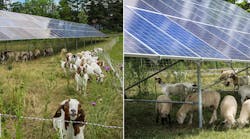NYPA, EPRI Complete Study on Sustainable Land Practices Integrating Agriculture and Solar Systems
Feb. 17, 2023
The New York Power Authority (NYPA) has released a new report, Agrivoltaic Leading Practices, that recommends proven and innovative approaches on integrating dual-land use for agriculture and solar energy production. The study determined that a best practice agrivoltaic site ideally involves stakeholder collaboration, community education, policy incentives, site safety practices, and site-individualized crop selection and solar array design.
“With this report, the Power Authority has drafted a blueprint for sustainable land practices to help guide New York to a more resilient, carbon-free future,” said New York Power Authority Acting President and CEO Justin E. Driscoll. “This agrivoltaic study provides significant insights for NYPA and New York State as we collaboratively work to meet our nation-leading climate and clean energy goals.”
Agrivoltaics is the simultaneous use of land for typical agricultural practices and photovoltaic (PV) power generation through the use of solar panels. Agrivoltaic systems are designed so that solar panels allow sufficient light to pass to ground crops while also capturing enough sunlight to generate electricity.
“Farmers have always been first and foremost stewards of the environment, taking great care, consideration, and patience in tending to the land that produces their harvest,” New York State Agriculture Commissioner Richard A. Ball. “NYPA’s work to research dual-land use for agriculture and solar energy production is an important step toward identifying successful outcomes that will balance our need for renewable energy, while sustaining our agricultural industry.”
In March 2022, NYPA announced receipt of a $102,000 grant to fund the report through the American Public Power Association’s (APPA) Demonstration of Energy & Efficiency Developments (DEED) program. The program funds research, pilot projects and education to improve the operations and services of public power utilities. NYPA collaborated with EPRI, an independent, non-profit energy research and development organization, to conduct research and publish the report.
Researchers who authored the new report examined how native vegetation, pollinators, low maintenance plants, agricultural crops as well as grazing livestock can coexist on the same parcel of land as a solar energy project.
The study determined that leading agrivoltaic practices are those that promote the following:
The research initiative is one of the Power Authority’s many innovative projects that support New York’s goal to generate 70 percent of the state’s electricity from renewables by 2030. The commitment includes the installation of 6,000 megawatts of solar power by 2025. New York is on target to meet that goal, and by annually installing more than 400 MW per year since 2018, it reached a combined total capacity of 3.3 GW of solar generation at the end of 2021.
NYPA completed an agrivoltaic system composed of 250 solar panels at the State University of New York (SUNY) College of Agriculture and Technology at Cobleskill in partnership with the college and the New York State Energy Research and Development Authority in 2015. The photo above is a picture of the SUNY Cobleskill system.In addition to the Power Authority’s efforts in agrivoltaics, New York State has established the Farmland Protection Working Group (FPWG) and the Agricultural Technical Working Group (A-TWG). The working groups are designed to ensure solar siting that is responsive to the needs of New York's agricultural communities.
The full Agrivoltaic Leading Practices report is available here. A webinar discussion about the report is taking place today and will be available to APPA DEED program members and others via the APPA website.
More information on the Power Authority’s efforts in creating a more sustainable New York State can be found on NYPA’s website.
NYPA is a long-time DEED program partner and received $250,000 to fund two demonstration projects in 2021—one that is analyzing the impact of ice on a hydropower plant and one testing an advanced technology that evaluates the health of high voltage assets in a substation.
